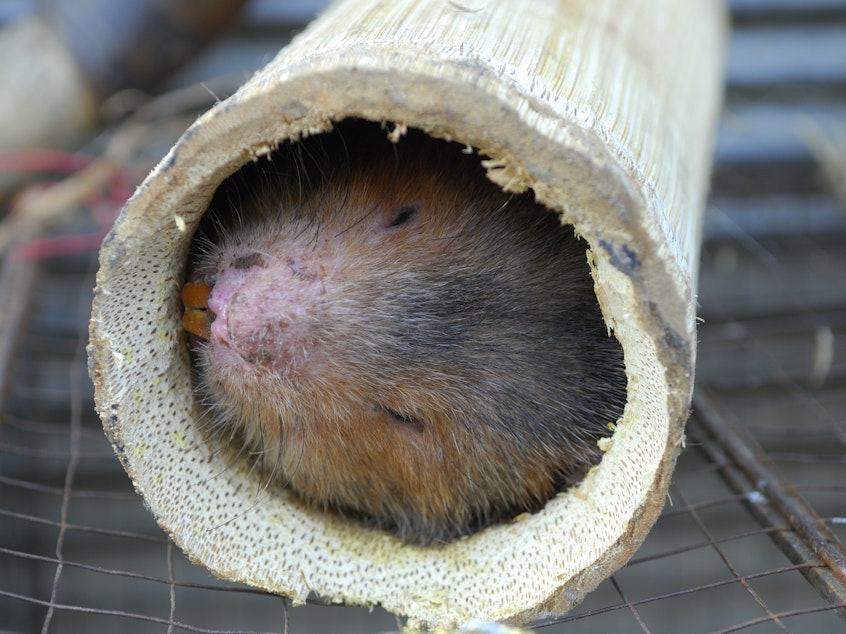WHO Points to Wildlife Farms in Southwest China As Likely Source Of Pandemic

A member of the World Health Organization investigative team says wildlife farms in southern China are the most likely source of the COVID-19 pandemic..
China shut down those wildlife farms in February 2020, says Peter Daszak, a disease ecologist with EcoHealth Alliance and part of the WHO delegation that travelled to China earlier this year. During that trip, Daszak says, the WHO team found new evidence that these wildlife farms were supplying vendors at the Huanan market in Wuhan with animals.
Daszak told NPR that the government response was a strong signal that the Chinese government thought those farms were the most probable pathway for a coronavirus in bats southern China to reach humans in Wuhan.
Those wildlife farms, including ones in the Yunnan region, are a part of a unique project that the Chinese government has been promoting for 20 years now.
"They take exotic animals, like civets, porcupines, pangolins, raccoon dogs and bamboo rats, and they breed them in captivity," says Daszak.
Sponsored
The agency is expected to release the team's investigative findings in the next two weeks. In the meantime, Daszak gave NPR a highlight of what they figured out.
"China promoted the farming of wildlife as a way to alleviate rural populations out of poverty," Daszak says. The farms helped the government meet ambitious goals of closing the rural-urban divide, as NPR reported last year.
"It was very successful," Daszak says. "In 2016, they had 14 million people employed in wildlife farms, and it was a $70 billion industry."
Then on February 24, 2020, right when the outbreak in Wuhan was winding down, the Chinese government made a complete about-face about the farms.
"What China did then was very important," Daszak says. "They put out a declaration saying that they were going to stop the farming of wildlife for food."
Sponsored
The government shut down the farms. "They sent out instructions to the farmers about how to safely dispose of the animals — to bury, kill or burn them — in a way that didn't spread disease."
Why would the government do this? Because, Daszak thinks, these farms could be the spot of spillover, where the coronavirus jumped from a bat into another animal and then into people. "I do think that SARS-CoV-2 first got into people in South China. It's looking that way."
First off, many farms are located in or around a southern province, called Yunnan, where virologists found a bat virus that's genetically 96% similar to SARS-CoV-2. Second, the farms breed animals that are known to carry coronaviruses, such as civet cats and pangolins.
Finally, during WHO's mission to China, Daszak said the team found new evidence that these farms were supplying vendors at the Huanan Seafood Market in Wuhan, where an early outbreak of COVID occurred.
The market was shut down overnight on December 31, 2019, after it was linked to cases of a what was described as a mysterious pneumonia-like illness.
Sponsored
"There was massive transmission going on at that market for sure," says Linfa Wang, a virologist who studies bat viruses at Duke-NUS in Singapore. He's also part of the WHO investigative team. Wang says after the outbreak at the Huanan market, Chinese scientists went there and looked for the virus.
"In the live animal section, they had many positive samples," Wang says. "They even have two samples from which they could isolate live virus."
And so Daszak — and others on the WHO team — believe that the wildlife farms provided a perfect conduit between a coronavirus-infected bat in Yunnan (or neighboring Myanmar) and a Wuhan animal market.
"China closes that pathway down for a reason," Daszak says. "The reason was, back in February, 2020, they believed this was the most likely pathway [for coronavirus to spread to Wuhan]. And when the WHO report comes out ... we believe it's the most likely pathway, too."
The next step, says Daszak, is to figure out specifically which animal carried the virus and on which of the many wild animal farms. [Copyright 2021 NPR]



